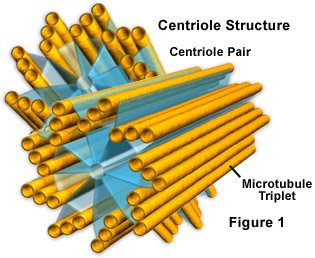Centriole
Centrioles (also centrioles ) are cylinder- shaped structures that are found in many living cells. They have a size of about 170 x 500 nanometers ( or about 1/2000 mm) and, together with the matrix perizentriolaren the centrosome (also centrosome ).
Significance of centrioles during transport and support tasks. So they are (along with the perizentriolaren matrix ) involved in the formation of the MTOC ( microtubule -organizing centers ) that the spindle apparatus for separating the chromosomes forms during mitosis and meiosis, but also during interphase to the organization and physical stabilization of the cell contributes.
Centrioles are found in most animal cells and the cells of lower plants, but not in the higher plants ( angiosperms). In ciliated cells, the centrioles are in interphase as flagellated basal bodies before, for example in the green alga ( Chlamydomonas reinhardtii ).
The centrioles of most mammals have 27 microtubules ( 9 triplets ), which are interconnected by filaments. The structure of the centrioles is often different: microtubule doublets in Drosophila microtubule singlets in the nematode C. elegans.









